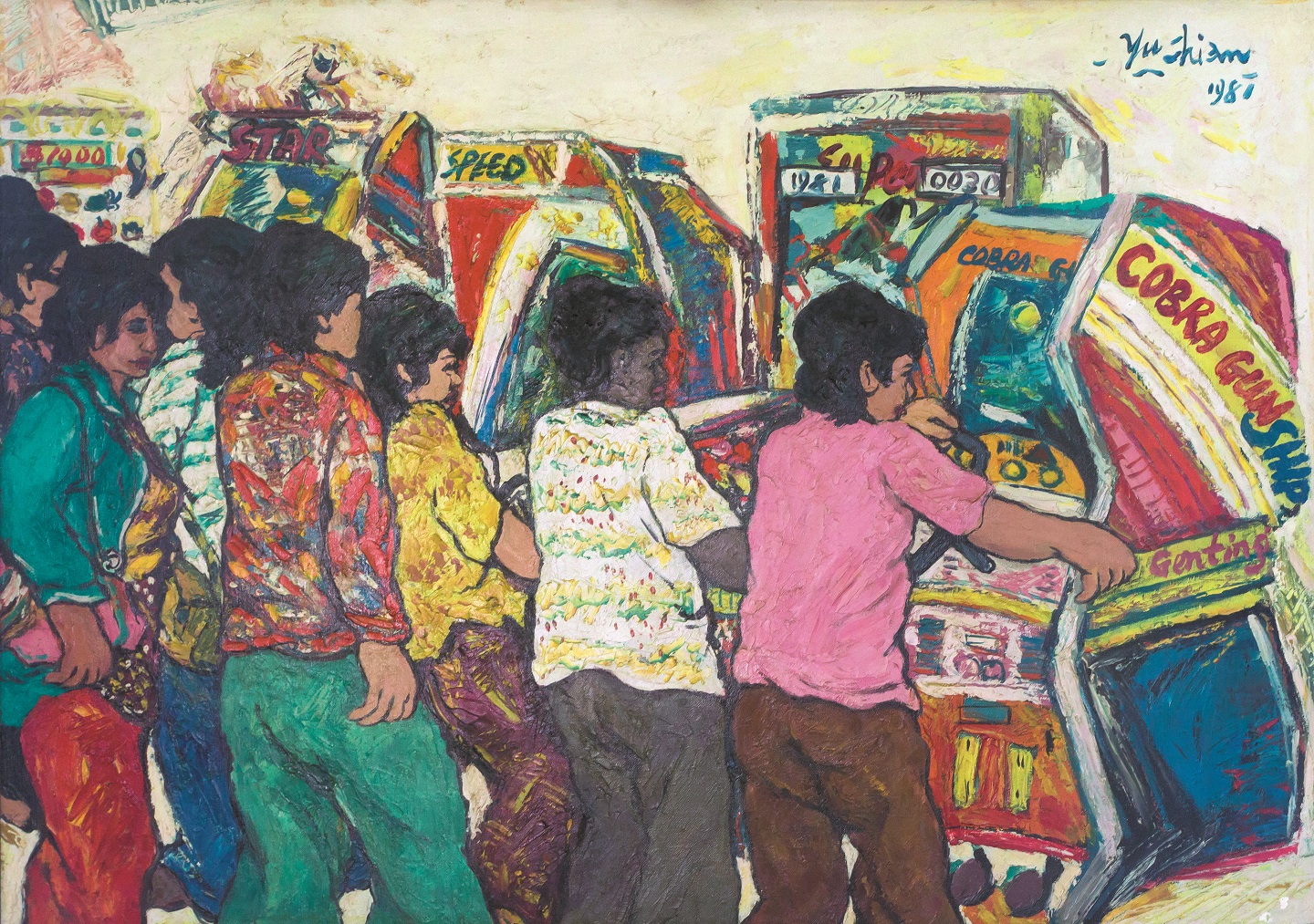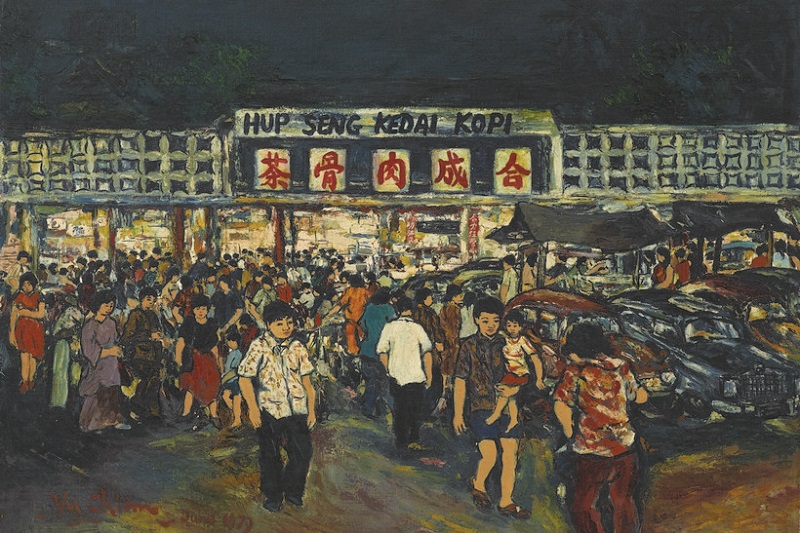
Playing the Slot Machine (1981) by Chia Yu Chian (All photos: Ilham Gallery)
Familiarity breeds affinity. Like the keen observer who grows accustomed to the faces he sees daily, Chia Yu Chian painted portraits of those who lived and worked around Selangor Mansion in Kuala Lumpur, his home for 25 years, layering his oil works with motion, emotion and a sense of place and time.
The late artist’s Private Lives, on show at Ilham Gallery in Kuala Lumpur, gives viewers the feeling that he got under the skin of his subjects and into their hearts as they went about their business in a working-class enclave that changed with the times but could not keep up with the prime and posher areas in the vicinity.
Selangor Mansion is in Jalan Masjid India, which runs parallel to the bustling thoroughfare of Jalan Tuanku Abdul Rahman. It is “a bird’s nest” — says a resident in a documentary produced in conjunction with the exhibition — where families, foreign workers and newcomers to the city flit in and out as they struggle to earn a living and tackle the curveballs life throws at them, in between rest, sleep and play.
Flats in the nine-storey block are carved into little rooms packed with all kinds of people and things that make up a home. Owners and tenants occupy the upper floors while the lower levels house grocery stores, eateries, laundries, printers, textile shops, hair salons, medicine halls and traders offering a myriad of products and services. Nearby are offices, flower and fruit stalls, bookstores, pawnshops, a bus station, rivers, historic buildings and cultural landmarks.

Chia would sit in his favourite coffee shop or wander around, observing the neighbourhood as it stretched and grew. Street scenes show customers thronging restaurants popular in the day, shoppers at open-air markets, people looking down from an overhead bridge, ongoing construction and the iconic Central Market, built as a wet market in 1888 and transformed into a tourist hub a century later.
He saw lawmen, criminals, old folk, young beauties, a teacher, a newspaper boy, hawkers, lovers, vagrants, drunkards, prostitutes and the deranged, and captured many of them up close, focusing on tired faces etched with anxiety, fear, shame and melancholy. Scattered among boisterous crowds are forlorn figures with hair streaked grey, backs bowed by care and legs bent with age.
Roving around the small towns in Perak, the artist stopped to watch workers sorting and packing groundnuts in a factory in Bidor and cars parked along narrow Temoh Street. In Penang, he witnessed happy families picnicking by a stream and at Genting Highlands, gamblers rushing into the casino or swaying at slot machines, as well as women sitting with arms crossed and stoic expressions. Was this his interpretation of expectation versus realisation?
In contrast to drab routine and grim reality, the works in Private Lives, painted between the 1970s and 1980s, is awash with bold strokes and vibrant colours, as if to show that people try to keep their spirits up even when things are not right. Chia dabbed a rainbow of hues on floral prints and frills, shirts, dresses, skirts, high heels, hats, wraps, shawls, sari, sarong and accessories that adorn hair, neck, ears and hands, enlivening his ordinary people with optimism and cheer.
Among the more than 160 exhibits is the intimate Hospital series — drawn from his own visits for treatment — which depicts concern, care, affection as family members hug patients huddled in anger, anguish and pain while doctors and nurses carry out their duties. Again, colour — flowers on a side table, a crying visitor’s blouse, even the striped garments patients wear — adds light to the sombre setting, a reminder that there is hope amid despair.

Chia was born in Kota Tinggi, Johor, in 1936 and studied art privately under Chen Wen Hsi, who taught at Singapore’s Nanyang Academy of Fine Arts. Through Chen, he met other pioneers of the Nanyang style, such as Cheong Soo-Pieng, and took part in group exhibitions with them.
In 1959, he became the first Malaysian artist to receive a French government scholarship to study at the Ecole Nationale Superieure des Beaux-Arts in Paris. Upon his return in 1962, he set up a gallery in Penang, where he lived for a year before moving south, ending up at Selangor Mansion, which became home and atelier, where he painted and taught art. He would live there until his death in 1990.
In Nine Storeys, the documentary produced by Mahen Bala, Chia’s daughter Meow Lin says he was the typical Chinese father — hot-tempered but quick to cool down and forget. He laughed, joked and played with his three children, often inventing games using simple objects. There was a lot of imagination and creativity, she adds. “My father brightened my life with colours, so much of colours when were were growing up”.
Private Lives, featuring works from the Chia family’s collection and pieces on loan by private collectors, is curated by Ilham Gallery director Rahel Joseph and Simon Soon, senior art history lecturer at the University of Malaya’s Cultural Centre.
'Private Lives', Ilham Gallery, Level 3 & 5, Ilham Tower 8, Jalan Binjai, KL. Tues-Sat, 11am-7pm; Until 5pm on Sunday.
This article first appeared on May 13, 2019 in The Edge Malaysia.


